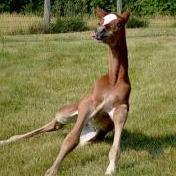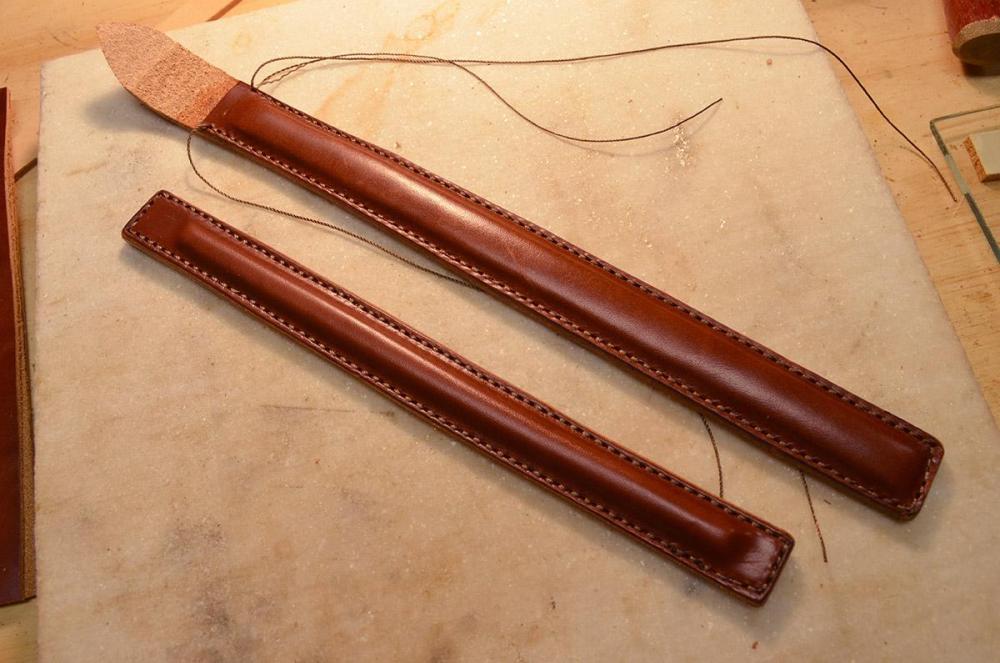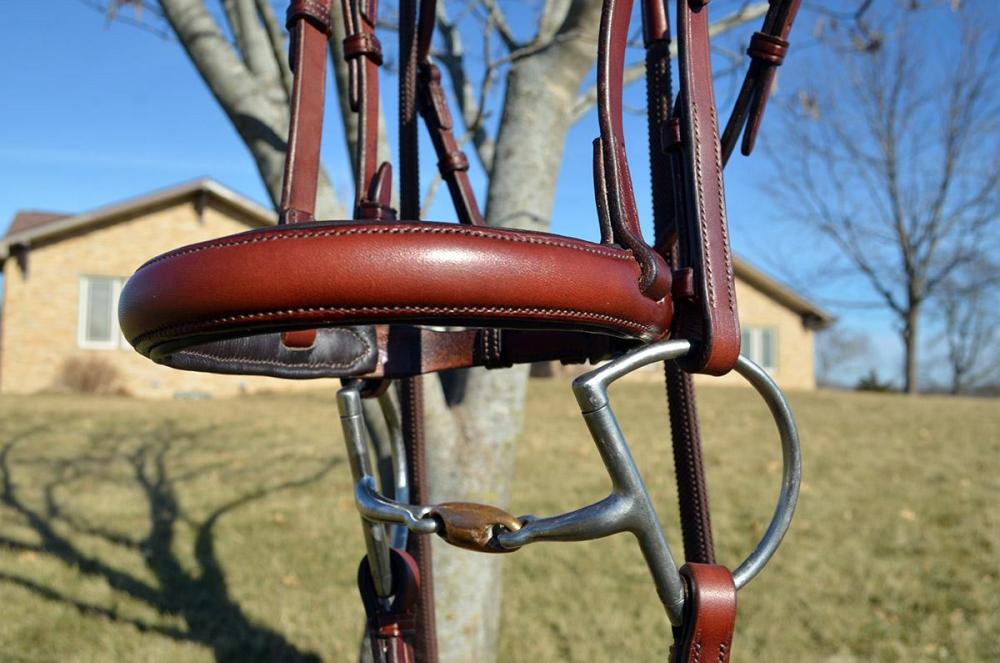-
Posts
1,284 -
Joined
-
Last visited
Content Type
Profiles
Forums
Events
Blogs
Gallery
Everything posted by TomE
-
I buy stamped stainless bridle buckles and stud hooks from Weaver, and most of my heavy brass halter hardware from Batz Corp. Abbey England has unique, high quality hardware for English tack but shipping is REALLY expensive, so I usually treat myself to a tool to justify the shipping cost.
-
@jcuk covered it well with the links. I'd only add that the first 2 video links are what I call a "swell" -2 straps with skived edges formed in a rounding block. The 3rd link is what I call "raised leather" - a split strap with a filler inserted. Whatever terminology you prefer they are different techniques. For swells I use a Japanese style knife or a head knife for most of the skiving and do a bit of leveling up with a French edger. I case the top strap after skiving and shape it in a rounding block, check its fit to the backer strap, then let it dry a few hours before gluing and assembling the 2 straps. I keep the backer strap dry and shape the curved front around it. I haven't figured out how to sew swells on a machine so I hand sew them. For raised leather I am splitting ~10 oz leather to ~ 3 oz of grain side and the rest as flesh side, or I split another strap for the backer so both sides have grain showing. The backer strap serves as a stiff platform to shape the grain side around a filler strip. I use a ~5 oz filler strip for a 10 oz split strap. The edges are trimmed after gluing and assembly, so I typically start with a strap that is ~3/8" wider than the desired finished width. You'll need a larger margin if sewing with a machine. An in-line or narrow pressor foot set will help. I have a bucket full of practice straps that are my raised leather graveyard. By playing around with thicknesses and widths you can create different looks.
-
Might try maintaining it like horse tack. Cleaning with saddle soap and water. Occasional oiling as needed with neatsfoot oil. Conditioning with a waxy conditioner like Fiebings Aussie or Black Rock Leather-N-Rich to repel water. English tack is not sealed with an acrylic top coat. Depend on regular cleaning, and conditioning with fats and oils to keep it supple and prevent dry rot. Another way to go is silicon oils for water proofing. Fiebings Saddle Oil (I use it on my work boots) or Golden Mink Oil.
-
I use mostly HO bridle leather and it bleeds a little dye when I wet form buckle turns or rounded straps - not to the extent you describe. If I split the pasted back off bridle leather then I usually reseal it with this flexible water based adhesive. I use a glass slicker to work it into the flesh side. It leaves a matt finish similar to a pasted back from the tannery. I think this would stop the bleed from the flesh side. It doesn't accept dye well if it gets on an edge before dyeing.
-
Thanks for the article, @chuck123wapati. Lots of good information about the chemistry of tanning and currying leather. I understand @SUP's point about the difference between producing leather and maintaining it with a conditioner, but I find it helpful to know what the starting point is at the tannery. Wish we had a reference section of this forum for depositing and downloading useful articles, book chapters, etc. I maintain my own collection but it is obviously not all-inclusive and it's fun to see what others turn up. Linen thread most certainly can rot. When repairing tack, I see linen thread that has deteriorated after decades of use. I don't know if it's caused by mold, a chemical used to maintain the tack, or something else. Coating linen thread with beeswax is supposed to help protect it, but for how long? There was a recent post asking where to find linen thread and the OP noted that Barbour has gone out of business. Campbell-Randall Corp. has a limited selection of Barbour thread. For hand sewing tack I mostly use bonded nylon thread from my machine, and for heavier weights I use waxed polyester thread from Maine Thread Co.
-
One knock against vegetable oils and olive oil is they attract rodents at least for tack stored in a barn. I would also consider lanolin as a vehicle for fats/waxes in a conditioner. Aussie conditioner and Effax Leder Balsam cause very little discoloration in comparison to Bick 4 or Black Rock Leather-N-Rich in my experience.
-
I think mineral oil is chemically inert and unlikely to react with anything in the leather. My concern would be the solvent-like properties of any oil applied to leather and the potential for over lubricating the fibers (spongey leather) and/or the potential to displace waxes, tannins, etc. The ideal oil would be readily absorbed so as not to remain on the surface and it would not change the temper of the leather, or do so in a controlled manner with additional applications. For me, neatsfoot oil fills the bill.
-
The care of vegetable tanned leather has different requirements than skin care. The leather has been exposed to harsh extremes of pH and reactive chemicals that break down the collagen fibers then bind them together with tannins. Oils and waxes are infused in the currying process to seal the leather and add suppleness. Oiling and conditioning aims to add back moisture and fats/waxes without removing what was introduced during the tanning processs. Are petroleum products OK to use? Yes and no. The Stohlmans mention in their Encyclopedia of Saddle Making that they made generous use of neatsfoot compound to good effect. Neatsfoot compound is a mixture of neatsfoot oil and petroleum based oils. They also mention that pure neatsfoot oil is preferable. Silicon oils are found in lots of leather care products including Fiebings Saddle Oil and Mink Oil. Great for waterproofing and softening leather. There is also too much of a good thing. Soaking leather tack in neatsfoot oil causes the leather straps to become permanently spongey and sticky to the touch. In my view the best products have limited ability to penetrate the leather and displace tannins, waxes, and other stuff we paid for when buying quality leather.
-
Very nice, sturdy looking halter. I like the fancy design on the cheeks.
-
It's standard practice to dye the edges of leather that has been dyed at the tannery and your edge treatment can really enhance the look of a bag - worth your time and some experimentation. I've never used an edge paint but I'd be concerned about how flexible it is and if it would wear well. My vote would be to test whether the edge can be burnished with something like Tokonole or Martin's Edge Solution. If it can be burnished then I would dye and burnish the edges instead of painting.
-
My favorite edge dye is a 50:50 mixture of Pro Dye and Martin's Edge Solution. Dye and burnish in one step, similar to the traditional dye/glue mixes that @jcuk posted. The Martin's Edge Solution smells a bit like acrylic floor wax but the burnished edge remains permeable to additional coats of dye. I finish the edge with a waxy conditioner or hot beeswax. Don't know what's in Edge Solution, but in my experience it produces more consistent results for bridle leather edges than other methods I've tried.
-

Move along and save or maybe take a risk
TomE replied to Webicons's topic in Leather Sewing Machines
You might enjoy Harry Rogers' book on shoe making. It is a detailed guide. (I haven't attempted making shoes) https://www.amazon.com/MAKING-HANDMADE-SHOES-STEP-STEP/dp/B0BM57TF35 His YouTube videos put a smile on my face. -
What type of machine, thread size, leather? Campbell Randall has a limited selection of Barbour linen thread.
-

Reinforcing: Leather case to carry a motorcycle battery
TomE replied to Littlef's topic in How Do I Do That?
Reminds me of a grownup version of the tennis ball cannons we built as kids, powered by lighter fluid. One idea for the case is to incorporate 1/4" plywood in the bottom to prevent sag. A number of the larger cases in Stohlman's book have wooden reinforcements, usually sandwiched between leather layers. Is this an AGM type battery? -
That's a smart looking bag and my wife would approve of the flap closure. Nice Work.
-
Might ask Springfield Leather. They do a lot of custom work and have a band splitter.
-

Spontaneous Combustion and Safety With Chemicals
TomE replied to Sheilajeanne's topic in Leatherwork Conversation
Saw a hay barn fire a few years ago while traveling along I-70 in Missouri. No one was on site and I think the fire was just starting. Next time I traveled that way the barn was gone. That's caused by microbial growth in the wet hay. My main hay supplier has a moisture tester on his baler that reads out % moisture content as the bales are produced. His hay doesn't sweat in the barn. Another reason round bales are popular is the whole process is mechanized and one person can produce and store the hay. It's getting hard to find kids who want to earn money bucking hay bales on a summer day. -
That's an odd diameter for a sanding sleeve. https://www.mcmaster.com/products/sanding-sleeves/ Perhaps you could switch to a standard size sanding drum on your arbor. I buy sleeves for my Cobra sander/burnisher from McMaster-Carr. They sell sanding drums as well.
-
Fun to try out different tools and learn new skills. That’s what it’s all about.
-
I just received a Gomph #12 and Osborne #10 overstitch wheels. Thinking about switching from pricking irons to these for bridlework. Faster and easier on the pocketbook.
-
I’ve been pleased with the Rocky Mountain European style pricking irons. I rarely use the 2-tooth iron and just tip and tap lightly. I assume you’re marking holes and sewing with an awl.
-
Received my spring punch from CSO today. Yes, they sent a new #0 punch tube with taller threads, and didn't do anything to the frame. I will sharpen the tube and be in business. It is a good size for Weaver's stamped bridle buckles.
-
Looks like a beast of a machine. Should be fun to work with.




